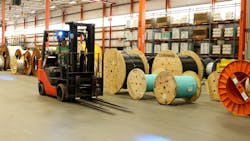Corning Optical Communications Goes Full Circle with Verizon And 5G
In 1970, three scientists at Corning developed the world’s first low-loss optical fiber, paving the way for today’s high-speed internet services and wireless 5G networks. In 2022, at Corning’s Hickory Manufacturing & Technology Center in Hickory, North Carolina, a private wireless 5G network supports experiments to further improve Corning’s fiber optic manufacturing processes.
“We’re doing this at one of the largest optical cable manufacturing plants in the world where we make the optical cable that forms the backbone of today’s telecommunications network. That includes Verizon’s 5G network that runs over our fiber and over our cable,” says Mike Bell, senior vice president and general manager at Corning Optical Communications.
“Now we’re leveraging those Verizon 5G capabilities in our factory, running over our infrastructure and some of our radio technology, to improve the way that we make that fiber and cable that feeds the 5G network in the first place,” Bell says.
Early Successes With 5G
Insights gleaned from Corning’s partnerships helped the company get the 5G network up and running in three months, enabling early experiments with parallel communication between autonomous mobile robots. “Then, we moved into a second phase where we said, ‘hey, let's start doing different kinds of experimentation with process control types of applications,’” Bell says.
Corning’s current experiments center on a pair of vision system technologies. The first system monitors the extrusion process that creates fiber optic cable, capturing images and feeding them via 5G network directly to computers that analyze the images to detect defects. The second system conducts high-speed inspection of a proprietary fiber production process, live feeding the data to a system that allows engineers to monitor trends.
“We picked one cable experiment, one fiber experiment, because we make both. So that was one of the things that was important to us,” Bell says. “We were looking for things that were real problems in our factories, not just to see if the technology could do a thing. We wanted to see if it could actually solve a real problem. And in both cases, the answer was yes. So that led us to say this could actually create some really interesting value and be transformative.”
The Inevitability of 5G Networks
Working with Verizon to install the 5G network extends a long-running collaboration between the two companies. “We’ve had a very deep collaboration with Verizon for many years. 2004 is when we announced their ‘fiber to the home’ program,” Bell says. “And that we were also a 5G network equipment provider just made it a natural thing for us to say yes to.”
Verizon in October 2019 announced the deployment of the 5G network at the Hickory plant. The technology is so new that, owing to a dearth of 5G-enabled devices, the plant required media converters, gateways and similar technologies to get the network up and running and ready to conduct experiments.
“There aren’t a lot of 5G network interface cards around yet, or any other devices. There are ways of converting the data from one protocol to another and so we have to put in special provisions for now,” says Bell. “I think that there weren’t even a whole lot of 5G phones around [in 2019], so it was really at a nascent state at that point.
“But we knew it was coming. Everybody was planning on it,” Bell continues. “And at a lot of the shows, including Mobile World Congress and lots of others, people were getting geared up to do this and they’d done all the tests and whatnot.”
Exploring Horizons With Verizon
Owing to the success of these early experiments, Bell imagines future advantages the Hickory plant may enjoy as a result. One idea involves 5G networks as a unifying technology for a plant, for example allowing a plant to push updates simultaneously to different PLCs on the floor instead of manually connecting computers to individual devices.
“Most manufacturers have a lot of invested capital, it’s unlikely you're going to go in and put something in and rip everything out and replace it,” Bell says. “So, to me, having some layer like 5G is a way to do what we were talking about [regarding PLC updates].”
“We look a lot at how we enhance our processes. If we have a particular process variable we want to control better, now, if you could do it through a camera system or some other sensor, you could put it on experimentally, you can make sure that it works if you have the right speed, reliability, latency,” Bell continues. “You can process it if it’s an image, you can process it with mobile edge compute. You can bring it back in the blink of an eye.
“And if you can get your PLCs and other parts of your network talking to this layer, well, then voila, you do have this sort of overlying layer,” Bell says. “I call it a product quality architecture layer that we’ve always desired to have. I think probably most forward-thinking manufacturing 4.0 thinkers would come to a similar conclusion.
“It’s nothing that we’re going to do tomorrow, but it’s something that we’re thinking about and just dreaming about,” Bell adds. “What else could you do with this? If these things work, that would be an implication in the future.”






